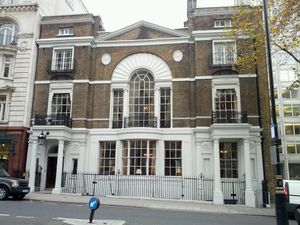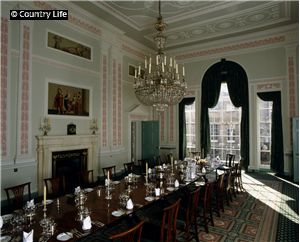Boodle's: Difference between revisions
mNo edit summary |
m (→Members) |
||
| Line 11: | Line 11: | ||
[[File:Boodles_dining_room.jpg|right|The dining room, Boodle's]] | [[File:Boodles_dining_room.jpg|right|The dining room, Boodle's]] | ||
==Members== | ==Members== | ||
(Note: Names in italics are former characters or NPCs) | |||
* [[Anthony Dunford]], the Duke of Claitonborough | * [[Anthony Dunford]], the Duke of Claitonborough | ||
* [[George Hackett]], Viscount Selwyn | * [[George Hackett]], Viscount Selwyn | ||
* [[Clarence Haworth]], Baron Louth | * ''[[Clarence Haworth]], Baron Louth'' | ||
* [[Henry Layton]], Earl Parry | * [[Henry Layton]], Earl Parry | ||
* The Hon. [[Frederick Lazenby]] | * The Hon. [[Frederick Lazenby]] | ||
* The Hon. [[Albert Mayoh]] | * The Hon. ''[[Albert Mayoh]]'' | ||
* [[Edmund Mayoh]], Viscount Wembury | * ''[[Edmund Mayoh]], Viscount Wembury'' | ||
* Mr [[Geoffrey Stapleton]] | * Mr ''[[Geoffrey Stapleton]]'' | ||
* [[James Vickery]], Viscount Saltash | * ''[[James Vickery]], Viscount Saltash'' | ||
* The Hon. [[Robert Vickery]] | * The Hon. [[Robert Vickery]] | ||
* Captain the Hon. [[John Vickery]], 60th Foot | * Captain the Hon. ''[[John Vickery]]'', 60th Foot | ||
<references> | <references> | ||
[[Category:Important Locations]] | [[Category:Important Locations]] | ||
Revision as of 11:29, 17 March 2017

Boodle's is a gentlemen's club located at 28 St James' Street. It is the second oldest of the various gentlemen's clubs, being founded in 1762. During the Regency, it had no real political alliance, unlike White's, which was staunchly Tory, and Brooks's which remained Whig.
To become a member, a man must be proposed by a current member, and a system of black and white balls was used to vote on the prospective man's membership. A single black ball was enough to exclude him from becoming a member, giving rise to the term 'blackballed'. This system was not exclusive to Boodle's, being used in other clubs.
Boodle's was located at No. 28 St. James's Street. Though such illustrious gentlemen as Wellington and Wilberforce held membership here, the majority of the members were country gentlemen who came to gamble and partake of the especially good food.
Smaller scale county affiliations were also connected to clubs, for example, Boodle's was associated with the country squirearchy, particularly men from Shropshire. Members of Boodle's could belong to all other clubs except Arthur's (est. 1811).[1]

Members
(Note: Names in italics are former characters or NPCs)
- Anthony Dunford, the Duke of Claitonborough
- George Hackett, Viscount Selwyn
- Clarence Haworth, Baron Louth
- Henry Layton, Earl Parry
- The Hon. Frederick Lazenby
- The Hon. Albert Mayoh
- Edmund Mayoh, Viscount Wembury
- Mr Geoffrey Stapleton
- James Vickery, Viscount Saltash
- The Hon. Robert Vickery
- Captain the Hon. John Vickery, 60th Foot
<references>